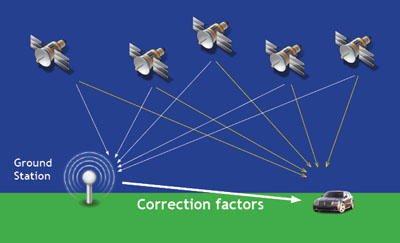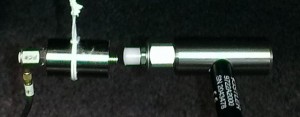 As you may know Prosig have recently released a GPS module for their popular P8000 series of data acquisition systems. The GPS module adds the ability to record accurate position information alongside all of the normal measurement channels. This is a highly useful capability and enables an engineer to easily correlate measured results with vehicle position and behaviour at the time. It also makes it simple to extract data based on position on a test track or road course.
As you may know Prosig have recently released a GPS module for their popular P8000 series of data acquisition systems. The GPS module adds the ability to record accurate position information alongside all of the normal measurement channels. This is a highly useful capability and enables an engineer to easily correlate measured results with vehicle position and behaviour at the time. It also makes it simple to extract data based on position on a test track or road course.
During the course of this work we have researched a great deal of information about GPS systems. Here are just some of the useful facts we have discovered.
What is GPS?
GPS (or Global Positioning System) is used to precisely calculate one’s latitude and longitude. It was originally developed by the US Department of Defense in 1973 to assist accurate location of military personnel and vehicles. The system has subsequently been extended to commercial and scientific use.Today, the uses of GPS have extended to include both the commercial and scientific worlds.
The GPS system is based on a network of 24 satellites that orbit the earth twice every 24 hours. This network of satellites is known as Navstar. The precise orbit of the satellites and their use of very accurate clocks allow precise triangulation of a users position. Each satellite transmits its exact position and a very accurate time. The accurate time required for GPS is provided by atomic clocks at the U.S. Naval Observatory. Each GPS satellite has atomic clocks on board. The satellites are synchronised and all repeatedly transmit at precisely the same time. These signals travel at the speed of light and arrive at the receiver at slightly different times depending on the distance between the receiver and each satellite.
Some interesting facts about GPS….
- The first GPS satellite was launched in 1978.
- The full complement of 24 satellites was reached in 1994.
- Each satellite is designed and built to last about 10 years. Replacements are constantly being built and launched into orbit.
- A GPS satellite weighs approximately 2,000 pounds and is about 17 feet across with the solar panels extended.
- Transmitter power is only 50 watts or less.
Who uses GPS?
Nowadays, GPS is available in many forms for navigation of cars, boats and planes. Devices are also available for use in recreational activities like hiking, mountain biking and so on. Even more recently, GPS systems are being routinely found in mobile phones (cell phones) and other mobile devices. Many branches of science make use of GPS with earth sciences being one of the biggest users. Meteorologists use it for weather forecasting and it is extremely useful to geologists who use it as a highly accurate method of surveying. GPS is also invaluable in earthquake studies to measure tectonic motions before, during and after earthquakes.
How does GPS work?
The basic principle of GPS location is fairly straightforward. Consider Figure 1 below. If we know the exact position of a satellite, S1, and we know that its signal took time, t1, to reach us then we can calculate the distance we are from the satellite. This locates us somewhere on a sphere surrounding the satellite. For the simplest ground based location we also know we are on a second sphere – the surface of the earth. So we can locate ourselves on a circle where those two spheres intersect.

If we now add data from a second satellite whose known position is S2 and whose signal takes t2 seconds to reach us, then we arrive at the scenario shown in Figure 2. Using the data from the two satellites and the knowledge that we are on the surface of the earth we can locate ourselves at one of two positions, L1 or L2.

It is now fairly obvious that if we receive a signal from a third satellite then we can locate ourselves precisely at one of the two possible locations. In figure 3 our position is now calculated at L2. A fourth satellite would enable us to also calculate our altitude. With GPS systems altitude is the distance we are above mean sea level (MSL). In aviation applications this is different from “height” which is generally used to measure the distance between ourselves and the ground.

How accurate is GPS?
Generally speaking, GPS will only work reliably when used in the open. Use inside buildings is unlikely to be successful. In fact, any object that is located between the satellite and the receiver, such as a tall building or mountain, can produce errors. Sometimes this error could be up to 30 metres. On the other hand, using a good quality GPS receiver combined with some of the techniques described below one can achieve accuracies of less than one metre.
There are many factors than can affect a GPS signal and thereby cause inaccuracy.
- The satellite signal is slowed as it passes through the atmosphere. These are known as ionosphere and troposphere delays. This is partially corrected by GPS systems which allow for average delays.
- Sometimes a signal can be reflected by large buildings or geographical features. The effect of this is for the signal to appear to take longer to reach the receiver.
- The built-in clocks in GPS receivers are not as accurate as the atomic clocks on board the satellites. This can lead to slight timing errors.
- Orbital errors. known as ephemeris errors, can cause inaccuracies in the satellite’s reported location.
- As described above a GPS receiver needs at least 4 satellites to calculate longitude, latitude and altitude. The more satellites over 4 that a receiver can “see” will improve the accuracy. If satellites become blocked by buildings, foliage or geographical features then the accuracy of the readings will decrease.
- The ideal positioning for satellites is to have them separated by wide angles. If the satellites are clustered to together or positioned roughly in line then errors increase in the geometry calculations.
- A deliberate degradation known as Selective Availability (SA) was imposed by the U.S. Department of Defense. This was intended to stop military adversaries from using the highly accurate GPS signals. This degradation was turned off in May 2000 and the accuracy of civilian GPS was significantly improved as a result.
Assisted GPS
Assisted GPS (also known as AGPS or A-GPS) is often found on mobile devices such as phones. It improves accuracy and availability of location information in two ways. First, it uses the mobile phone network to retrieve satellite location information. This enables the GPS receiver to obtain a faster “time to first fix” (TTFF). This means that the information does not need to be downloaded from the satellite and the receiver can get valid position data more quickly. Second, if the GPS signal is weak or unavailable, AGPS will use position information for mobile phone base stations to triangulate a position.
A similar system is employed by manufacturers of GPS and Satnav devices. This involves pre-loading them with satellite position information from the Internet. This enables them to more quickly get a fix on satellites for a fixed period, typically a few days or a week.
Differential GPS
Differential GPS (also known as DGPS) is a system used to improve the accuracy of GPS data. It uses a network of ground stations precisely located at known positions. The ground stations are not used in the GPS location calculation. They use their precise position to calculate any error from the received satellite data and produce local correction factors. These correction factors can then be transmitted to the GPS receiver.

As we see in Figure 4 both the base station and the GPS equipped vehicle receive data from the same satellites. However, the base station knows its exact location so it can compare this with the location calculated from the satellite data. From this is can work out local correction factors which it then transmits. These are received by the vehicle GPS receiver and used to correct the satellite readings it receives.
Other systems
In addition to the Navstar GPS system described in this article there are a number of other systems currently being implemented.
Europe’s Galileo is due to be operational in 2014 and will consist of a constellation of 30 satellites in Medium-Earth Orbit (MEO), 30-40 sensor stations, 3 control centres, 9 Mission Uplink stations and 5 TT&C (telemetry, tracking & command) stations.
The GLONASS system was begun by the former Soviet Union in 1976, with a goal of global coverage by 1991. The entire constellation of satellites was completed in 1995, but the system fell into disrepair with the collapse of the Russian economy. In 2001 working with partners including India, Russia committed to restoring the system by 2011.
The Chinese are launching satellites for their own Compass system which is planned to have global coverage by 2012/13.
Some further reading
Here are some of the articles that assisted in the writing of this article and that offer some more in depth examinations of the issues discussed above…
How does the Global Positioning System work? from pocketgpsworld.com
What is GPS? from garmin.com
How WAAS Works – It’s Not Rocket Science from maps-gps-info.com
How Is The Accuracy Of A GPS Receiver Described? from romdas.com
Chris Mason
Latest posts by Chris Mason (see all)
- Rotating Machinery Vibration Analysis: Keeping Your Machines Humming Along - November 27, 2023
- Vibration Control and Isolation: A Comprehensive Guide for Engineers - November 6, 2023
- Modal Analysis in the Real World - October 6, 2023





Interesting! Have you chosen the Sirf Prima chip, it supports as well the Galileo system witch is more sensitive when the satellites is shadowed by H2O.
Very good article…well explained…thanks
please give more more no detail about the gps by using the ppt
how the signals will be process
A ship’s captain once told me that in the street of Gibraltar, the accuracy was less (because it is of military importance). I wondered how it is possible to have locally reduced accuracy.
Bert
(Not afraid to ask)
Hi Bert
Thanks for the question. It’s an interesting one. I don’t think it would be possible to do this from the satellite as that would effect everywhere on the earth where that satellite was visible. I suppose some form of local jamming could be used (don’t forget GPS fails quite easily when the signal is reflected by tall buildings or geographical features). But whether that could be done while still letting those who needed it (the military) have accurate readings I don’t know. If there is poor GPS in parts of Gibraltar it might simply be caused by the rock itself.
It is possible and actually being done by giving deliberately erroneous data of particular satellites positions. The military GPS receivers have extra data decoding possibilities (frequencies and codes to receive on those frequencies) thus not using the erroneous data.
Thanks, Uldis. That is interesting. Is this different to the ‘Selective Availibility’ that was removed from GPS a while ago? It is mostly the reliance on military cooperation that has driven the development of competing systems such as Galileo.
Probably it sounds like a conspiracy theory, but I suspect them still using SA as an exception and keeping it classified info as it can be the best way to achieve own troops with precise position and deny it to opposing force. It can also be possible to use local jammers on the non military frequencies, but then there is still the question of having enough special receivers as in Gulf War.
That certainly sounds plausible. I shall just remain grateful that I can use my phone to stop me getting lost quite so often 🙂
Are you sure A-GPS uses triangulation based on known angles and not trilateration based on signal strength?
Yes, you are correct. Strictly speaking it is not ‘triangulation’ which requires angles.